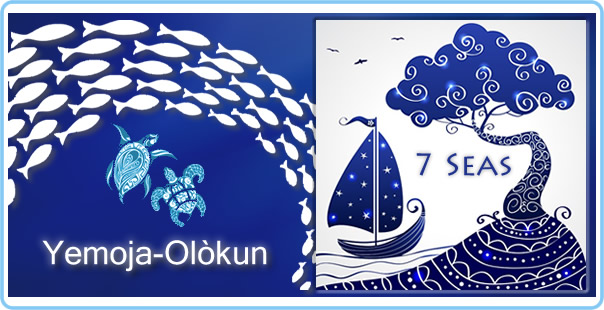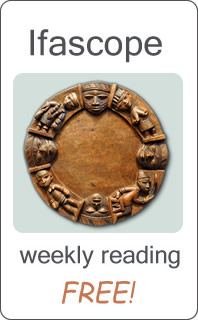Yemoja-Olokun & story of creation
 Wednesday, September 21, 2016 at 7:43PM
Wednesday, September 21, 2016 at 7:43PM 
It is a widely held belief by scientists that life began in the ocean roughly 3.8 billion years ago in thermal vents on the ancient seafloor bed which were created by the separation of tectonic plates. Even today, these hot vents continue to sustain an ecosystem in the dark depths of the ocean. Some scientists speculated about the possibility that it could also have started in tide pools and hot springs formed by the tectonic plate movements. What makes these scientific findings interesting from our point of view, is the correlation of science and the Ifa beliefs of creation passed down through generations in the form of “Patakis” (Ifa stories or myths).
There are many versions of the story of creation in the Ifa myths, suffice to say that you can choose one that resonates with you, this is my adaptation of the story. But first, for the benefit of people new to Ifa, and to put the story into context, I want to say something about the Orishas mentioned in the story.
Yemoja (Yemonja, Yemaya) - the name is derived from the Yoruba words “Yeye” or “ìyá” (mother), “ômô” (child) and “eja” (fish) so literally translates to “mother whose children are fish”.
Olòkun (the name is derived from the Yoruba word “Olohun” (owner) and “òkun” (sea/ocean) so literally translates to “owner of the oceans”)
Yemoja-Olòkun are discussed together as they have a symbiotic relationship, forever linked together. The essence of Yemoja is felt in all large bodies of water including the great lakes and the vast oceans and as deep as sunlight can reach. The essence of Olòkun and its’ great mysteries are beyond the reach of sunlight, it lies in the dark depths of the oceans which humans with all the advancements in technology, still know very little about.
Obatala (Orisanla) – the name is derived from the Yoruba words “Oba” (master/king/lord/leader), “ala” (whiteness/purity), translating to “master of purity” or “king of the white cloth”.
Odùduwà (Odudua, Oduas) – the name is derived from the Yoruba words “Olohun” (owner), “dudu” (black/dark), the word “odu” also means womb so literally translates to “the dark womb”.
The energies of Obatala and Odùduwà complement each other as each have influence over the mind. Obatala is said to rule over the conscious mind while Odùduwà is said to rule over the subconscious mind. "Light / Dark", "Expansion / Contraction".
Eshu (Esu, Elegua, Elegba, Elegbara, Echú), the messenger of God - Olodumare and the Orishas. Eshu can bridge the spiritual world with the tangible world. It is said that Eshu is everywhere at any given moment, waits at the crossroads between heaven and earth. Known as “the trickster” because it grant us “free will”, the freedom to make choices, for better or for worse. The trick is making the right choices as Eshu not only facilitates life lessons, but rewards us from the spirit world. Eshu is the creator of opportunities and can remove obstacles from your path.
The story of creation:
 As the legend goes, Yemoja-Olòkun and its’ watery world were alone in the cosmos for a very long time incubating the life that was to come into the world. God, Olodumare (Olorun, Olofi) sent Obatala, the “divine sculptor” along with Odùduwà to shape the world. They were guided by Eshu who creates opportunities for life.
As the legend goes, Yemoja-Olòkun and its’ watery world were alone in the cosmos for a very long time incubating the life that was to come into the world. God, Olodumare (Olorun, Olofi) sent Obatala, the “divine sculptor” along with Odùduwà to shape the world. They were guided by Eshu who creates opportunities for life.
They descended from heaven in a beam of light resembling a golden chain as bright as the sun. Obatala brought the "Igba Iwa" ("calabash of existence"), it contained fertile soil (“Ashe” - life-giving energy), a palm seed, and a mythical five-toed rooster to scratch the earth, spread the soil and bury the seed of life. As the earth broke open (tectonic plates), other Orishas joined in to help the new world. The seed grew into an enormous tree.
When it came time for humans to be created, Obatala molded them from mud and clay. It was at this time that “sap” (palm wine – also known as “strong white mimbo”) started to come out of the palm tree. Palm wine is highly intoxicating and Obatala drank from it, falling asleep. This allowed, Odùduwà who rules the subconscious mind to then impart wisdom and instincts, the connection to the divine. Nothing is by chance in Olodumare’s plan. The symbolism is that the conscious mind as represented by Obatala need to go to sleep in order to reach the subconscious mind as represented by Odùduwà.
Yemoja has many children as well as devotees, she is the quintessential mother, loving and nurturing, she embodies “family”. Olòkun brings you stability (inner strength) and prosperity, supporting and enriching your life in so many ways.
The number “7” is significant and associated with Yemoja-Olòkun, perhaps a reference to the moon and the lunar cycle where each moon phase last a little over 7 days. The combined gravitational forces exerted by the Moon and the Sun causes the rise and fall of the tides. Or perhaps the number “7” is a reference to the 7 major tectonic plates (African; Pacific; North American; South American; Eurasian; Antarctic), or the 7 Seas (Arctic Ocean; North Atlantic Ocean; South Atlantic Ocean; Indian Ocean; North Pacific Ocean; South Pacific Ocean; Antarctic Ocean).
Offerings to Yemoja-Olòkun
- Fruit: pomegranate, watermelon, cantaloupe, melon, mangos, coconut, pineapples, papayas, grapes, pears, bananas, cramberries
- Vegetables: yams, seaweed (e.g. wakame, dulse, nori, sea grapes)
- White wine
- Sweets: Molasses; rice cakes
- Shells: cowries; abalone; various conch shells; nautilus shells; triton/trumpet shells
- Gemstones: turquoise; lapis lazuli; coral; mother of pearl; moonstone; clear crystals.
- Metal: Silver
- Flowers: large flowers (e.g. blue hibiscus, orchids), hydrangeas, blue and white flowers
- Colors: deep blue, white, turquoise
- Scent: sandalwood, lilac, verbena, tea rose
Celebration days:
- September 7th (Northern hemisphere)
- February 2nd (Southern hemisphere)
- Eve of Summer Solstice (around June 20-22nd)
- Full moon days
Love and Blessings! Javier Lujan {Babalawo Ifajuitan}





Reader Comments